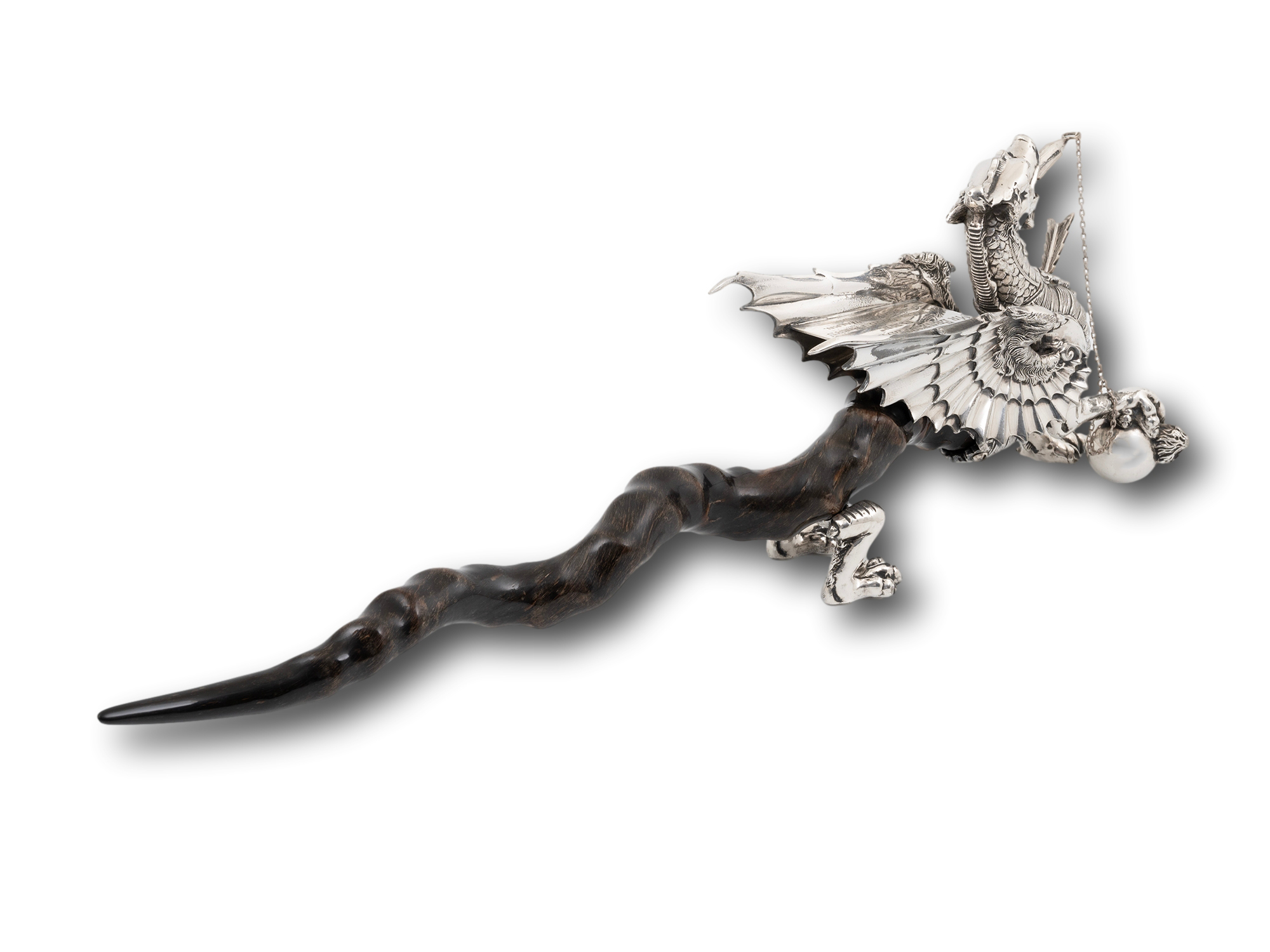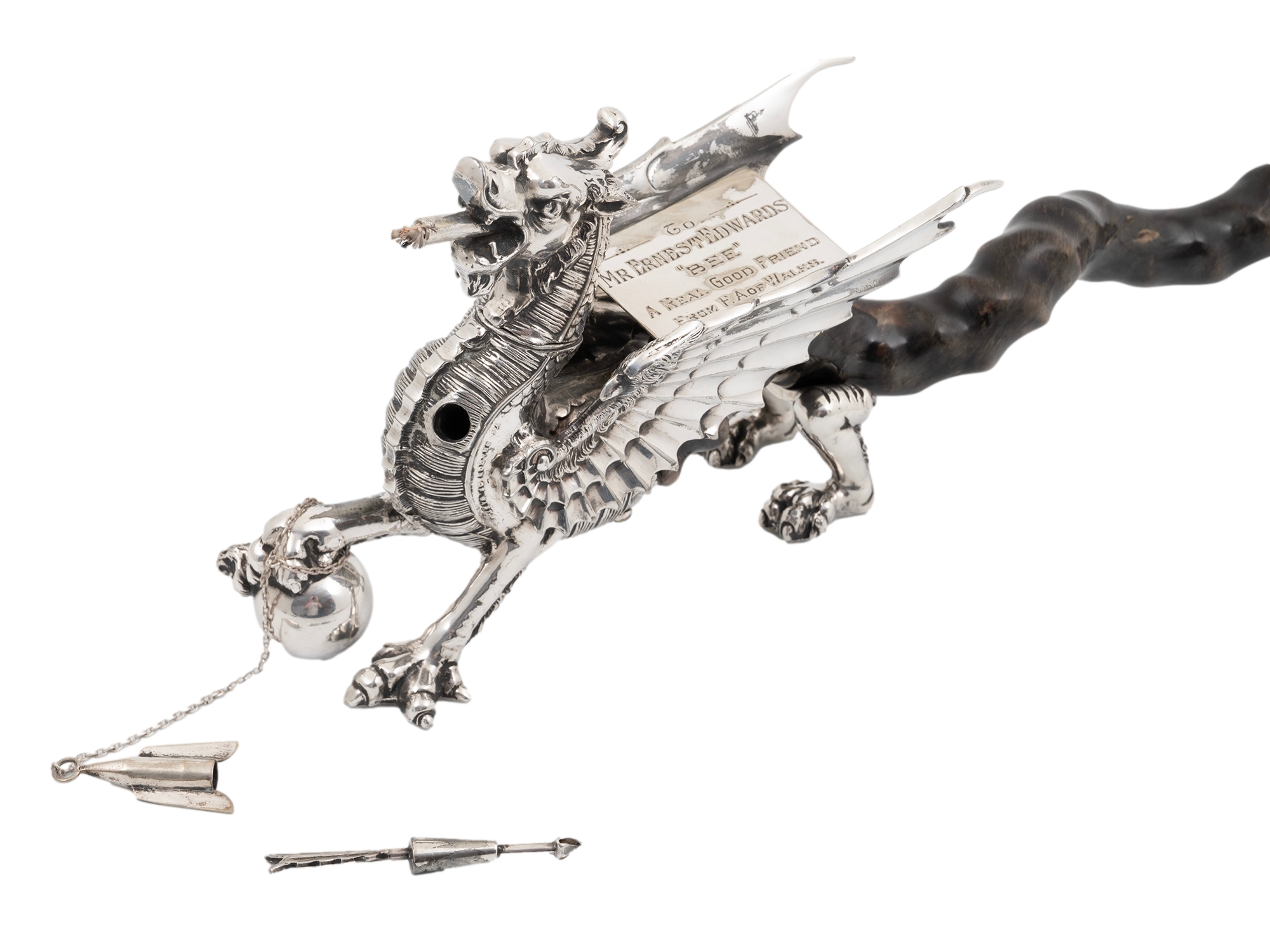Dragon Table Lighter Gifted to Earnest ‘Bee’ Edwards
£3,950.00
Dragon Registration Number 51318 From our Silver collection, we are absolutely thrilled to introduce direct from the family a Dragon Table Lighter Gifted to Earnest 'Bee' Edwards. The lighter in the form of a dragon stood upon a flaming grenade... Read More
Walker and Hall Silver-Plate Military Mess Dragon Table Lighter Gifted to Earnest ‘Bee’ Edwards by the Welsh F.A – Liverpool Football Club Provenance

| Dimensions | 47 × 7.5 × 15 cm |
|---|---|
| Country | |
| Medium | |
| Period | |
| Year | |
| SKU | 501528 |
Description
Description
Dragon Registration Number 51318
From our Silver collection, we are absolutely thrilled to introduce direct from the family a Dragon Table Lighter Gifted to Earnest ‘Bee’ Edwards. The lighter in the form of a dragon stood upon a flaming grenade with a tail formed from Blackbuck Antelope horn. The dragon stands with its mouth agape with the wick simulating the dragon breathing fire with a chained candle snuff. To the front of the dragons chest is a removable tamper in the form of an arrow flanked by the phrase “Ye Dragon of Wantley” in reference to the dragon of Wantley, a legend of a dragon-slaying knight in Whancliffe Crags in South Yorkshire. The story is told in Thomas Percy’s 1767 “Reliques of Ancient English Poetry”. Between the wings of the dragon is a unique plaque which reads “To Mr Ernest Edwards “Bee” A Real Good Friend From F.A of Wales” below the flag hallmark for Walker and Hall. The Dragon Table Lighter Gifted to Earnest ‘Bee’ Edwards dates to the first quarter of the 20th century circa 1915.
Ernest “Bee” Edwards
The military mess table lighter was presented to Ernest “Bee” Edwards by the Welsh Football Association. Unlike other versions of this stylish lighter, this version has a unique silvered plaque between the two wings. Ernest Edwards was known as “Bee” from his early days and he kept it throughout his career. In 1904 Bee became the first ever sports editor of the Liverpool Daily Post and Echo. He reported on Liverpool and Everton matches every week and had a keen following amongst supporters, many of whom speculated on which side he favoured most. He is widely credited as being the person who came up with name of “The Kop” at the Liverpool football stadium for the new terrace built in 1906. He also tested the limits of the corner kick rule with player Sam Chedgzoy being paid £2 by him to participate. Bee also came up with an idea along the lines of a Fantasy Football League and once acted as a player’s agent for player Bert Freeman who eventually signed for Everton. His career spanned over 30 years and throughout his time he kept up with new ways of communicating and new formats for sports reporting. He broadcast on local radio, he edited a weekly magazine for Vernon’s Pools then in its infancy, he interviewed footballers on Pathe Newsreel, and once appeared as a guest on This is Your Life which followed the life of Arthur Christiansen the legendary editor of the Daily Express. In the early days, his reports were sent by pigeon from the press box at Anfield or Goodison to the newspaper office in Victoria Street. Later he was the only sports reporter at Liverpool with access to a phone, and thereby was able beat his rivals to print.
The Spion KOP at Anfield
The KOP at Liverpool’s Anfield home ground has long been regarded as one of the nosiest and most passionate stands in all of football. When the sports editor of the Liverpool Daily Post and Echo, Ernest “Bee” Edwards talked to the new owners of the club, they all agreed a new stand was needed to ensure the safety of the fans. Construction started on the new stand and in the process a huge open-air embankment was created. After seeing the materials of cinder and brick the resemblance of earthwork was shaped like the Spion Kop (a famous battle in the Boer War). Edwards came up with the name in tribute for the many Scousers who had lost their lives there six years before. Edwards said at the time,“ this huge wall of earth has been termed ‘Spion Kop’, and no doubt this apt name will always be used in future in referring to this spot.”
Literature Mark Goodger 25th Anniversary Catalogue Page 64
User Instructions Inflame the wick that hangs from the mouth by using a lighter or a match. In the event the wick is dry, lighter fuel should be used, which can be purchased from any tobacconist. In order to burn the wick some fuel needs to be dripped on it, this can also be applied to its interior by removing the head. (This is also what you must do if the wick runs out in the future). Once you have unscrewed the head, you will see the remainder of the wick, which can be filled with fuel by unscrewing the head carefully. You may have to pull the wick out a little 2-3 mm from the mouth if it gets too short. Note, if it gets pulled too far out the flame will become too big. When the wick eventually runs out it will need replacing.
Silver-Plate is a term used when objects are primarily made of other metals and coated with a thin layer of silver. Often the base layer of the object is brass. The item is made the base metal and then dipped in a silver solution giving the item a silver appearance. As the object is not Solid Silver it bares slightly different hallmarks to traditional Silver and will not feature the Sterling Silver identification.
With every purchase from Mark Goodger Antiques, you will receive our latest catalogue, a Certificate of Authenticity, detailed care instructions for your chosen piece and an independent invoice (for insurance purposes) will be enclosed. As well as being protected by a no-hassle, money-back policy, your piece will be entirely insured during the shipping process to ensure the safety of your item.
Additional information
Additional information
| Dimensions | 47 × 7.5 × 15 cm |
|---|---|
| Country | |
| Medium | |
| Period | |
| Year | |
| SKU | 501528 |















